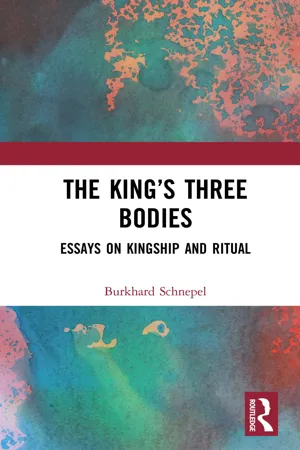We thus have to recognize [in the king, B.S.] a twin person, one descending from nature, the other from grace. . . . One through which, by the condition of nature, he conformed with other men: another through which, by the eminence of [his deification, B.S.] and by the power of the sacrament [of consecration, B.S.], he excelled all others. Concerning one personality, he was, by nature, an individual man: concerning his other personality, he was, by grace, a Christus, that is a God-man. (Norman Anonymous as cited in Kantorowicz 1957: 46; brackets by Kantorowicz)
The king is a twinned being, human and divine, just like the Godman, although the king is two-natured and geminate by grace only and within Time, and not by nature and (after the Ascension) within Eternity: the terrestrial king is not, he becomes a twin personality through his anointment and consecration. (ibid.: 49; Kantorowicz’s emphasis)
In sum, the liturgical kingship of the monastic High Middle Ages was based on the idea of a divine prototype, Jesus Christ, who has two natures, human and divine, and two functions, royal and priestly. Added to this was the idea of the king as the image or representative of Christ on earth. This imago or vicarius Christi has, like his prototype, two natures: the human nature comes to him per naturam, whereas the divine nature he holds only per gratiam, through the ritual of anointment and consecration. And like his divine prototype, the earthly king has two functions, that of priest and king.7
As Kantorowicz points out, the Norman Anonymous’s main source of inspiration was theological: his ideas were Christocentric and Christological, and the duplications of the royal person were mirror images and imitations of the duplications of Jesus Christ. However, at the time when this author was writing, the concept of the king as imago Christi was already out of fashion, and the Christocentric-liturgical concept of kingship was about to give way to one which was rather theocratic-liturgical. The ensuing law-centred kingship of the twelfth century saw the gradual substitution of the Bible as an authoritative text by Roman law; instead of the Books of Kings or Romans 13, for instance, we find references to the Law Books of Justinian. Simultaneously, from being the imago of Christ, the king developed more and more into an imago dei, a mirror image of the just God and father, and, still later, of the Goddess Justitia. The king’s relationship with law and justice became significant, while the importance of his relationship with the altar and the sacrament diminished: law replaced liturgy. Kantorowicz characterizes these developments, which started under Frederick II, as follows:
The mediaeval patterns and concepts of kingship were not simply wiped out, neither by Frederick II nor by others: practically all the former values survived – but they were translated into new secular and chiefly juristic modes of thinking and thus survived by transference in a secular setting. Moreover, the patterns and values were rationalized not by means of theology, but preferably by means of scientific jurisprudence. (ibid.: 115)
In this context, we also find that duplications of the king no longer took a Christological form. The king was henceforth regarded as someone who stands above as well as beneath the law, being the fountain and the servant of justice at the same time, a twinned nature aptly expressed in the metaphor of the king as pater et filius justitiae. While the change from a liturgical to a juridical kind of kingship was fluid, so that the conceptions may well have existed simultaneously, there was one important change: grace no longer played a role. We recall that in the Norman Anonymous’s earlier conception, the king only participated in the divine nature of Christ per gratiam. But where did this grace come from, if not through an act of anointment and consecration? And who conducted this ritual, if not the bishops or the pope? Thus, with the diminishing importance of grace as the basis of the king’s legitimacy, the Church lost its decisive power in the making of a king. And no doubt the struggles for power between the popes and the emperors (or between popes and kings) was one driving force behind these changes in the political theology of the time.8
In general, the history of Church-State relations in medieval Europe was one of mutual borrowings of various kinds and at many levels. However, the character of these borrowings changed during the fourteenth and fifteenth centuries, when emphasis was laid less on ruling personages than on ruled collectivities. A polity-centred kind of kingship came into being. In Kantorowicz’s words, ‘the field of mutual influence, expanding from individual dignitaries to compact communities, henceforth was determined by legal and constitutional problems concerning the structure and interpretation of the bodies politic’ (ibid.: 193). The term corpus mysticum or body mystical, which stood at the forefront of theories of corporations at that time, initially had a purely sacramental meaning, denoting the consecrated host in the Eucharist. But from the early fourteenth century onwards we encounter the concept of the Church as the body mystical of Christ, Christ himself being its head. This new concept provided the basis for a duplication of the body of Jesus Christ that differed from the older distinction between his two natures in being sociological in content: it distinguished an individual and natural body of Christ on the one hand and a collective and mystical body of Christ on the other. The concept of ...
